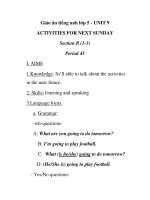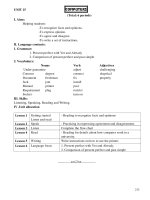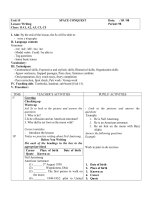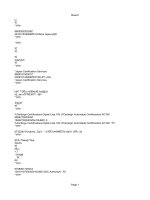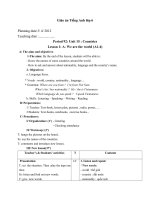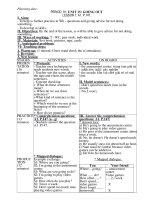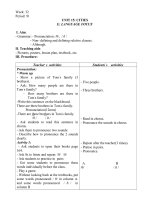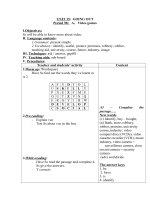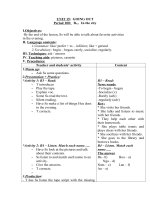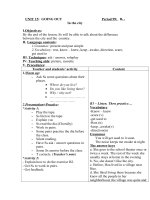Giao an Tieng anh lop 3 Unit 15 Lesson 21 2 3 Vnen
Bạn đang xem bản rút gọn của tài liệu. Xem và tải ngay bản đầy đủ của tài liệu tại đây (96.54 KB, 3 trang )
<span class='text_page_counter'>(1)</span>Unit 15: Do. you have any toys?. Lesson 2: 1, 2, 3 Objective:. I.. By the end of the lesson, pupils will be able to ask and answer the questions about the toys.. II. Language focus: 1. Vocabulary: a yo-yo, a ship, a plane, a kite. 2. Sentence Patterns: Does your brother have a robot? – Yes, he does/ No, he doesn’t.. III. Teaching aids: 1. Teachers’ aid: 2. Students’ aids:. Students’ and teacher’s book, pictures, cassette, puppets. books, notebooks, workbooks.. IV. Procedures: 1. Warm - up: -. Play a small game: SLAP. a doll -. a car. THE BOARD a robot. a puzzle. Explain the rule of game. Let pupils play the game.. 2. Look, listen and repeat. Activity 1: (Whole class – Group work) Set the scene: Asking pupils some questions: + How many people are there in the pictures? – There are three people. + Where are they? – They are in the living room. + Who are they? – This is Quan. This is Linda. This is Peter. + What do Peter have? - Have pupils listen to the conversation to know what happen to them. (book closed) Have pupils listen again. (books opened) T explains the structure:.
<span class='text_page_counter'>(2)</span> Structure: Quan: Does your brother have a robot? Linda: Yes, he does. + T gives some examples then asks pupils to give examples, using the structures. + Ask pupils to write the structures down their notebooks. Let pupils listen and repeat the conversation. (2 times). Activity 2: (Group work) . Guide the class role play in pairs. Go around and check each pair then give comment. Call some pairs to perform in front of the class. Give pupils comments.. 3. Point, ask and answer: Activity 1: (Whole class) -. Have pupils look at pictures a, b, c, d on page 32. Use the pictures and mining to teach the words: a yo-yo, a ship, a plane, a kite. Ask pupils to repeat each words a few minutes. Have pupils practice saying words in group.. Activity 2: (Whole class) Checking – up: Checking – up: rub out and remember. Have pupils look at the pictures and name them about the toys.. Activity 3: (Pair-work): Have pupils look at a picture (a yo-yo), elicit to ask and answer: Example: Nam: Does he have a yo-yo? Mai: Yes, he does. Call 1 pupil to practice together. Have pupils repeat the question and the answer. Call 2 pupils role play in front of the class. Have pupils work in group to practice asking answering, using the structure and new works. - Go around and check all groups while they are working. - Check all groups while they are working. - Check some pairs in front of the class. (if necessary) - Give feedback.. 4. Let’s talk:.
<span class='text_page_counter'>(3)</span> Activity 1: (Pair-work): Show pictures and give task. Have pupils work in pairs to practice asking and answering about the toys, using the structure. - Go around and check. - Call some pairs to perform in front of the class. - Check and correct. (if necessary) - Give feedback. Have pupils copy the lesson in the notebooks.. 5. Pupils’ evaluation: -. Ask pupils to evaluation themselves in their group. The group leaders tell T their study result. T gives comments and educates the students through the lesson.. 6. Home-link: -. Practice reading the conversation at home and then practice asking and answering the questions about the toys: . V.. Does he have a yo-yo? -Yes, he does.. Comments: ………………………………………………………………… ………………………………………………………………… ………………………………………………………………… …………………………………………………………………..
<span class='text_page_counter'>(4)</span>
